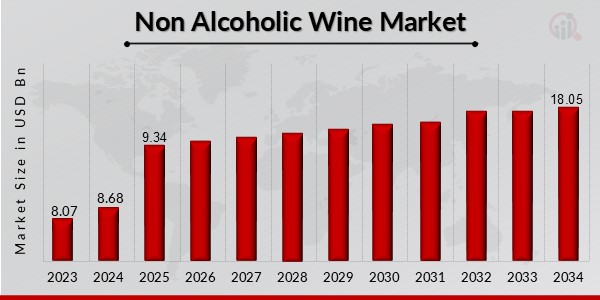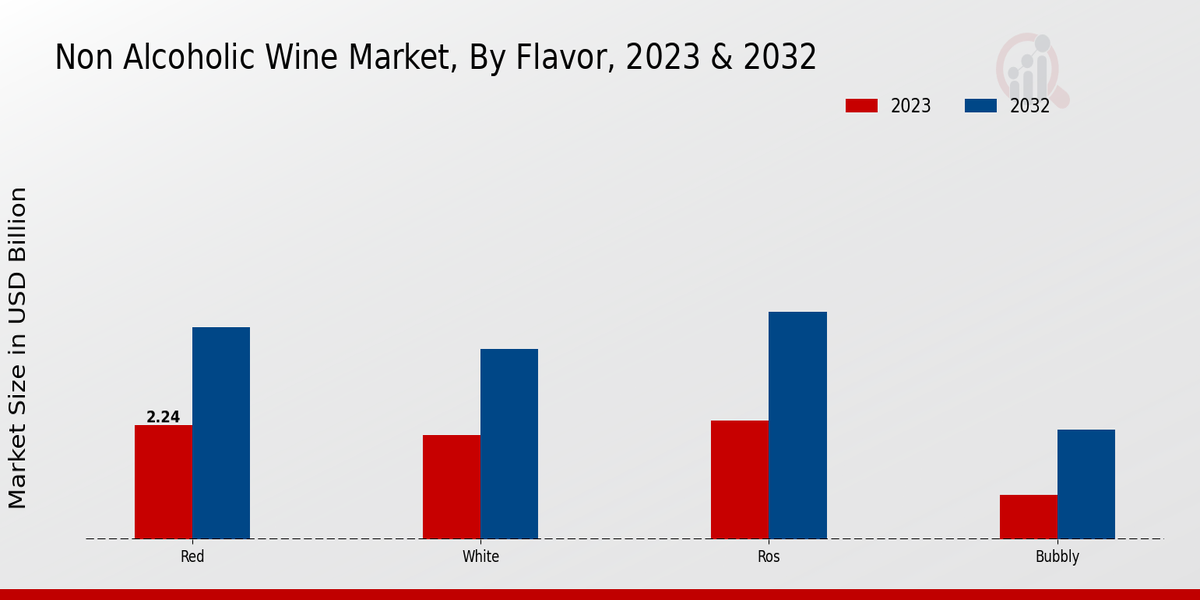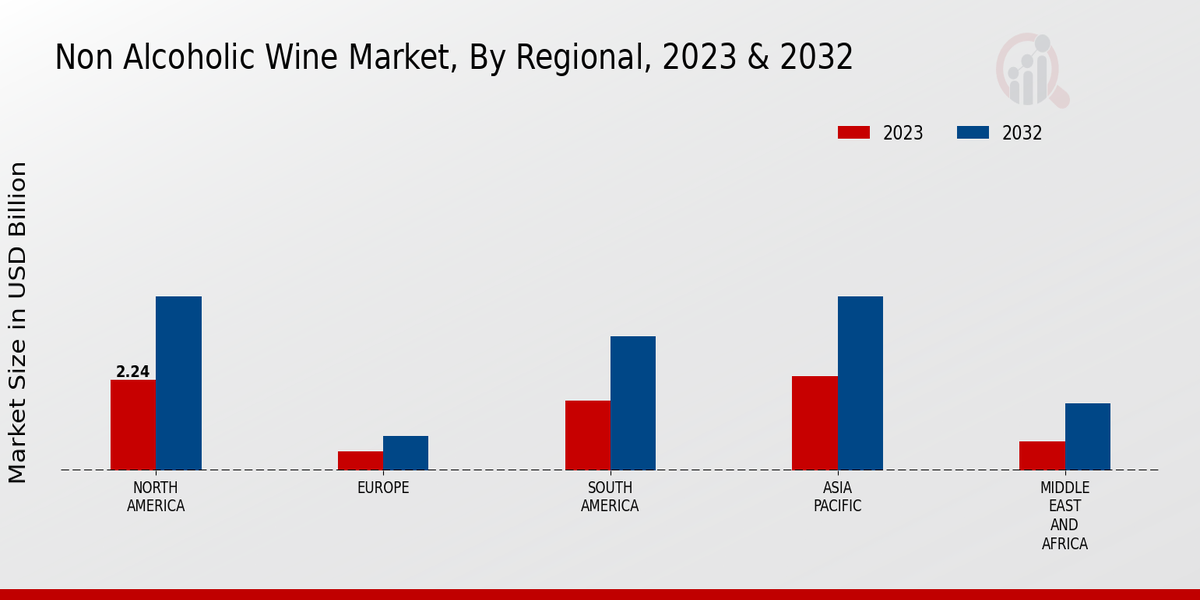Global Non-Alcoholic Wine Market Overview
Non-Alcoholic Wine Market Size was estimated at 8.68 (USD Billion) in 2024. The Non-Alcoholic Wine Market Industry is expected to grow from 9.34(USD Billion) in 2025 to 18.05 (USD Billion) by 2034. The Non-Alcoholic Wine Market CAGR (growth rate) is expected to be around 7.6% during the forecast period (2025-2034).

Source Primary Research, Secondary Research, MRFR Database and Analyst Review
Key Non-Alcoholic Wine Market Trends Highlighted
Rising health consciousness, evolving consumer preferences, and the rising demand for healthier alternatives to traditional alcoholic beverages are the main reasons for the non-alcoholic wine market growth. Alcohol-related concerns and changing lifestyles make consumers increasingly health-conscious, and unhealthy choices like the intake of alcohol are being avoided. There is a growing trend to drink non-alcoholic wine because people have realized they do not have to be drunk in order to enjoy life and socialize with friends.
Some of the potential areas of growth in the market are through innovation and satisfying the needs of health-oriented consumers. Non-alcoholic winemakers are able to develop complex tastes and scents that can compete with customary wine debido advanced methods of production. The inclusion of low-calorie and no-sugar options will, in addition, grow the market further. This implies that the market is more inclined to tap into this wider demographic by meeting the needs of overweight and diabetic consumers.
Recent trends in the non-alcoholic wine market include the increase of remote sales channels and the increase in popularity of e-commerce. Quite often, consumers greatly appreciate the range and quality of products offered by Internet shops. Subscriptions and direct sales via e-commerce channels have also been adopted by consumers as they offer ease in seeking out different non-alcoholic wine brands.
Non-Alcoholic Wine Market Drivers
Rising Health Consciousness and Focus on Healthy Lifestyles
Consumers are becoming increasingly aware of the negative health effects associated with excessive alcohol consumption, leading to a shift towards healthier beverage options. Non-alcoholic wine offers a satisfying alternative that allows individuals to enjoy the taste and experience of wine without alcohol-related risks. As the population becomes more health-conscious, the demand for non-alcoholic wine is expected to continue growing steadily.
This market driver is particularly prominent in developed regions such as North America and Europe, where consumers are actively seeking healthier and more balanced lifestyles.
Expansion of Non-Alcoholic Wine Offerings
Non-Alcoholic Wine Market Industry is Foreseeing an Escalation in Merchandise Development and Assortment. Manufacturers are continuously enriching their Non-Alcoholic wine offerings to deal with altering customer tastes. New flavors, varietals, and packaging choices are some of the factors driving growth in the market. In addition, due to the inclusion of Non-Alcoholic wine in numerous outlets, such as digital retailers, markets, and eateries, consumers now have improved availability and quality.
Growing Popularity of Sober Curious Movement
The movement of sober curious, which inspires people to stop or take fewer drinks, is gaining popularity all over the world. One of the driving forces promoting this trend is the many different factors regarding the idea of alcohol's effect on individuals’ health, productivity, fitness, and so forth. Clearly, this lifestyle, which is adopted by an increasing number of people, will lead to a rising demand for non-alcoholic wine in the future. This sober, curious movement is mainly practiced by the younger generation, which is open to new liquid consumption habits.
Non-Alcoholic Wine Market Segment Insights
Non-Alcoholic Wine Market Flavor Insights
Non-Alcoholic Wine market is segmented by Flavor, Red, White, Rosé, and Bubbly. Red is expected to hold a significant share of the market in 2023, whereas Bubbly is projected to grow at a CAGR during the forecast period. Red The red wine flavor is expected to hold a significant share of the market on account of the rising popularity of non-alcoholic red wine as a healthier alternative to traditional red wine. Non-alcoholic red wine offers a similar aroma and flavor profile characteristic of red wine; the key differentiating factor is the negligible to zero alcohol content in non-alcoholic red wine.
Red wine nowhere ensures consumption of red wine with no amount of alcohol, which is provided by the non-alcoholic wine segment to the consumers that prefer the flavor of wine, namely red, but not the alcoholic effect. Consequently, rising awareness of the product offerings and availability is expected to drive the market. White The white wine segment is also expected to hold a substantial share of the market due to the growing popularity of non-alcoholic white wine owing to its flavor profile; light and crisp, and a preferable alternative to showcase taste for classic wines.
In addition, non-alcoholic white wine is a preferable alternative to carbonated drinks and fresh juices, which are excessively sweet. Rosé Rosé wine is also expected to hold a considerable market share due to relatively lighter flavor profiles over other flavors. It is a preferable choice for outdoor sitting and pool parties. The relatively reduced sugar content and negligible alcohol content in non-alcoholic rosé wine are not only expected to gain preference among retail consumers but also among consumer segments drinking cocktails and their respective mixers.
Bubbly The Bubbly flavor is expected to have the highest CAGR over the forecast period. Rising consumer demand for non-alcoholic sparkling wine as a celebratory beverage over sodas, resulting in increased expenditure on non-alcoholic beverages on account of increasing awareness of products available, is expected to drive the segment growth.

Source Primary Research, Secondary Research, MRFR Database and Analyst Review
Non-Alcoholic Wine Market Packaging Insights
The packaging segment plays a crucial role in the Non-Alcoholic Wine Market, influencing consumer purchasing decisions and product preservation. Bottles, cans, and kegs are the primary packaging formats used in this market. Bottles hold a significant market share due to their premium image and ability to preserve the wine's flavor and aroma effectively. Glass bottles, particularly those made from dark-tinted glass, offer protection from light exposure, ensuring the wine's quality. Cans, on the other hand, have gained popularity due to their convenience and portability.
They are lightweight, unbreakable, and easy to transport, making them suitable for outdoor activities and on-the-go consumption. Kegs are primarily used for commercial purposes, such as bars and restaurants, as they allow for easy dispensing and storage of larger volumes of non-alcoholic wine. The Non-Alcoholic Wine Market is expected to witness significant growth in the coming years, driven by increasing health consciousness and the expansion of the non-alcoholic beverage industry.
Non-Alcoholic Wine Market Sweetness Level Insights
The Non-Alcoholic Wine Market is segmented by Sweetness Level into Dry, Semi-Dry, Semi-Sweet, and Sweet. Among these, the Dry segment held the largest market share in 2023, accounting for over 40% of the Non-Alcoholic Wine Market revenue. The preference for Dry, Non-Alcoholic Wine can be attributed to its versatility and ability to pair well with various foods. Semi-dry and Semi-Sweet segments are also gaining popularity, as they offer a balance between sweetness and acidity. The Sweet segment, while having a smaller market share, caters to consumers who prefer a sweeter taste profile in their Non-Alcoholic Wine.
Non-Alcoholic Wine Market Ingredients Insights
The Ingredients segment of the Non-Alcoholic Wine Market is projected to expand significantly, driven by rising consumer demand for healthier and alcohol-free alternatives. Grapes are expected to remain the dominant ingredient, accounting for over 55% of the market share in 2023. The popularity of grapes stems from their natural sweetness and ability to produce a wide range of flavors. Apples, pears, and berries are also gaining traction as key ingredients, with their unique taste profiles and health benefits. Apples offer a crisp and refreshing flavor, while pears add a smooth and velvety texture.
Berries, rich in antioxidants and vitamins, contribute a vibrant color and fruity sweetness to non-alcoholic wines. The increasing availability of these ingredients in organic and sustainable forms is further propelling market growth.
Non-Alcoholic Wine Market Regional Insights
The regional segmentation of the Non-Alcoholic Wine Market offers valuable insights into the market's geographical distribution and growth dynamics. North America is projected to dominate the market, accounting for a significant share of the Non-Alcoholic Wine Market revenue in 2024. The region's well-established distribution networks, growing health consciousness, and increasing adoption of non-alcoholic beverages contribute to its leading position. Europe follows closely behind, driven by a growing demand for premium non-alcoholic wine alternatives and a strong culinary culture.
The Asia-Pacific region presents significant growth opportunities, with rising disposable incomes and changing consumer preferences towards healthier beverage options. South America the Middle East, and Africa regions are expected to witness steady growth, fueled by increasing urbanization and evolving consumer lifestyles.

Source Primary Research, Secondary Research, MRFR Database and Analyst Review
Non-Alcoholic Wine Market Key Players And Competitive Insights
The Non-Alcoholic Wine Market industry is highly competitive, characterized by the presence of both and regional players. Leading Non-Alcoholic Wine Market players are constantly striving for product innovation, strategic partnerships, and geographical expansion to gain a competitive edge. Market development has been driven by increasing consumer demand for healthier and alternative beverage options, as well as growing awareness of the negative impacts of alcohol consumption.
One of the leading players in the Non-Alcoholic Wine Market is Luminara Wines. The company offers a range of sparkling and still non-alcoholic wines made from premium grapes and natural flavors. Luminara Wines has gained recognition for its commitment to quality and innovation, with its products receiving numerous awards and accolades. The company has expanded its presence globally, partnering with distributors and retailers to meet the growing demand for non-alcoholic wine alternatives.
A notable competitor in the Non-Alcoholic Wine Market is BevZero, a leading producer of non-alcoholic beer and wine. BevZero has gained traction with its wide range of non-alcoholic wine offerings, including Cabernet Sauvignon, Chardonnay, and Rosé. The company has focused on delivering high-quality, affordable, non-alcoholic wines that cater to the growing health-conscious and sober-curious consumer base. BevZero has established distribution partnerships with major retailers and restaurant chains, expanding its reach and gaining market share. The company continues to invest in product development and marketing campaigns to strengthen its position in the Non-Alcoholic Wine Market.
Key Companies in the Non-Alcoholic Wine Market Include
-
Ariel
-
Le Petit Béret
-
Borrago Wine Company
-
NEWBOLD
-
Vinadeis
-
Lyre's
-
Surely
-
Eisberg
-
Freixenet
-
Jus Jus
-
Testet
-
Noughty
-
Splash Wines
-
Oddbird
Non-Alcoholic Wine Market Industry Developments
The Non-Alcoholic Wine Market is anticipated to grow at a CAGR of 7.59% during the forecast period of 2024-2032. The market is expected to reach USD 14.5 billion by 2032, up from USD 7.5 billion in 2024. This growth is attributed to increasing health consciousness among consumers, rising demand for low-calorie and sugar-free beverages, and the growing popularity of alcohol-free social gatherings.
Key recent developments in the Non-Alcoholic Wine Market include
In 2023, Heineken launched a new non-alcoholic beer called Heineken 0.0, which has been well-received by consumers.
In 2022, Anheuser-Busch InBev launched a new non-alcoholic beer called Budweiser Zero, which is also gaining popularity among consumers.
In 2021, Carlsberg launched a new non-alcoholic beer called Carlsberg 0.0, which has been successful in several markets.
These developments indicate that the Non-Alcoholic Wine Market is a growing and dynamic market with significant potential for future growth.
Non-Alcoholic Wine Market Segmentation Insights
Non-Alcoholic Wine Market Flavor Outlook
Red
White
Ros
Bubbly
Non-Alcoholic Wine Market Packaging Outlook
Bottles
Cans
Kegs
Non-Alcoholic Wine Market Sweetness Level Outlook
Dry
Semi-Dry
Semi-Sweet
Sweet
Non-Alcoholic Wine Market Ingredients Outlook
Grapes
Apples
Pears
Berries
Non-Alcoholic Wine Market Regional Outlook
North America
Europe
South America
Asia Pacific
Middle East and Africa
| Report Attribute/Metric |
Details |
| Market Size 2024 |
8.68(USD Billion) |
| Market Size 2025 |
9.34(USD Billion) |
| Market Size 2034 |
18.05(USD Billion) |
| Compound Annual Growth Rate (CAGR) |
7.6% (2025 - 2034) |
| Report Coverage |
Revenue Forecast, Competitive Landscape, Growth Factors, and Trends |
| Base Year |
2023 |
| Market Forecast Period |
2025 - 2034 |
| Historical Data |
2019 - 2023 |
| Market Forecast Units |
USD Billion |
| Key Companies Profiled |
Ariel, Le Petit Béret, Borrago Wine Company, NEWBOLD, Vinadeis, Lyre's, Surely, Eisberg, Freixenet, Jus Jus, Testet, Noughty, Splash Wines, Oddbird. |
| Segments Covered |
Flavor, Packaging, Sweetness Level, Ingredients, Regional. |
| Key Market Opportunities |
1 Rising health consciousness2 Growing demand for alcohol-free options3 Expanding product portfolio4 Increasing adoption in social gatherings5 Expansion into new regions |
| Key Market Dynamics |
Rising health consciousness Growing demand for low-calorie beverages Technological advancements Expanding product portfolio Increasing popularity of online sales |
| Countries Covered |
North America, Europe, APAC, South America, MEA |
Frequently Asked Questions (FAQ) :
The non-alcoholic wine market is expected to reach a valuation of USD 9.34 billion in 2025.
The non-alcoholic wine market is projected to grow at a CAGR of 7.6% from 2025 to 2034.
North America is expected to hold the largest market share in the non-alcoholic wine market, owing to the growing popularity of non-alcoholic beverages and the presence of major non-alcoholic wine producers in the region.
Non-alcoholic wine is primarily consumed as a social beverage, but it is also used in cooking and baking.
Key competitors in the non-alcoholic wine market include Heineken, Carlsberg, Diageo, and Constellation Brands.
The growth of the non-alcoholic wine market is driven by factors such as the increasing demand for healthier beverages, the growing popularity of non-alcoholic beverages, and the rising awareness of the harmful effects of alcohol consumption.
The non-alcoholic wine market faces challenges such as the high cost of production and the limited availability of non-alcoholic wine options.
Opportunities for the non-alcoholic wine market include the growing demand for healthier beverages, the increasing popularity of non-alcoholic beverages, and the rising awareness of the harmful effects of alcohol consumption.
Key trends in the non-alcoholic wine market include the increasing popularity of zero-proof wines, the growing demand for non-alcoholic wines with natural ingredients, and the rising awareness of the health benefits of non-alcoholic wines.
The future outlook for the non-alcoholic wine market is positive, with the market expected to continue growing in the coming years.
















